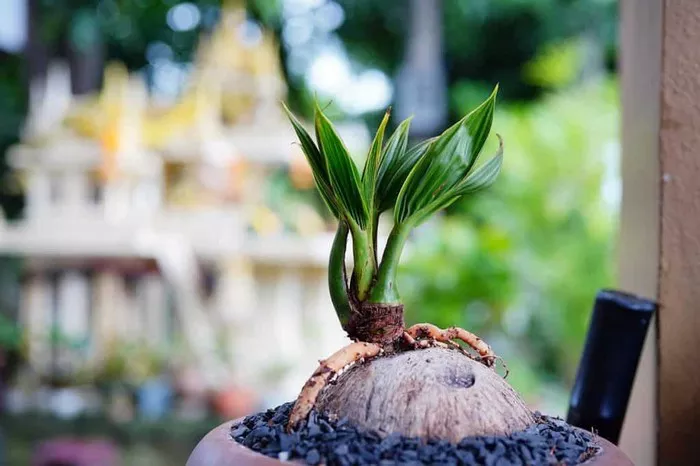Coconut bonsai, with their striking resemblance to their larger counterparts, offer a captivating glimpse of the tropics in miniature form. While traditional bonsai techniques are often associated with temperate trees, the art of cultivating coconut bonsai brings a unique challenge and reward to enthusiasts. With patience, attention to detail, and proper care, anyone can successfully grow and maintain these stunning miniature palm trees. In this comprehensive guide, we will explore the intricacies of growing coconut bonsai, from selecting the right specimen to mastering pruning and maintenance techniques.
Understanding Coconut Bonsai: Origins and Characteristics
Before diving into the cultivation process, it is essential to understand the unique characteristics of coconut bonsai. The coconut palm (Cocos nucifera) is a symbol of tropical paradise, known for its tall stature and bountiful fruit. In bonsai form, the coconut palm retains its iconic fronds and slender trunk but on a much smaller scale.
Coconut bonsai, like their full-sized counterparts, thrive in warm, humid climates. They require ample sunlight, well-draining soil, and regular watering to flourish. While growing coconut bonsai presents its challenges due to their tropical nature, the results are undeniably rewarding for dedicated enthusiasts.
Selecting the Right Specimen
Choosing the right specimen is the first step towards growing a successful coconut bonsai. When selecting a coconut palm for bonsai cultivation, several factors should be considered:
Size: Opt for a young coconut palm with a manageable size, as larger specimens can be challenging to train into bonsai form.
Health: Look for a healthy plant with vibrant green foliage and no signs of disease or pest infestation.
Trunk: Select a specimen with a straight, slender trunk that reflects the graceful form of a mature coconut palm.
Root System: Inspect the root system to ensure it is well-developed but not overly bound, as this can impede growth and development.
Ideally, choose a coconut palm that has been grown specifically for bonsai cultivation or select a young plant from a reputable nursery.
Cultivation Techniques
Once you have selected the perfect specimen, it’s time to begin the cultivation process. Growing coconut bonsai requires a combination of traditional bonsai techniques and specialized care tailored to the needs of tropical plants.
Potting and Soil: Transplant the coconut palm into a shallow bonsai pot filled with well-draining soil. A mix of sand, perlite, and organic matter, such as coconut coir or peat moss, works well for coconut bonsai. Ensure the pot has adequate drainage holes to prevent waterlogging, which can lead to root rot.
Watering: Coconut bonsai require regular watering to maintain soil moisture levels. Water thoroughly when the top inch of soil feels dry to the touch, ensuring excess water drains freely from the pot. Avoid overwatering, as this can lead to root rot and other moisture-related issues.
Lighting: Place the coconut bonsai in a location with ample sunlight, preferably in a south-facing window or outdoors in a sunny spot. Adequate sunlight is essential for healthy growth and vibrant foliage.
Temperature and Humidity: Coconut bonsai thrive in warm, humid environments reminiscent of their tropical origins. Maintain temperatures above 60°F (15°C) and humidity levels between 50-70%. In drier climates, consider using a humidity tray or misting the foliage regularly to increase moisture levels.
Fertilization: Feed your coconut bonsai with a balanced liquid fertilizer during the growing season, typically from spring to early fall. Dilute the fertilizer to half the recommended strength to avoid overfeeding, which can damage the delicate roots of the bonsai.
Pruning and Training: Regular pruning is essential to maintain the compact size and graceful form of the coconut bonsai. Remove any dead or yellowing fronds, as well as any suckers or offshoots that emerge from the base of the trunk. Additionally, gently bend and wire the fronds to create the characteristic curvature of mature coconut palms. Exercise caution when wiring to avoid damaging the fragile leaves.
Challenges and Solutions
While growing coconut bonsai can be a rewarding experience, it also presents its challenges. Tropical plants are more susceptible to temperature fluctuations, pests, and diseases compared to their temperate counterparts. Here are some common challenges encountered when growing coconut bonsai and how to address them:
Root Rot: Overwatering or poor drainage can lead to root rot, a fungal disease that affects the roots of the bonsai. To prevent root rot, ensure the soil is well-draining and only water when necessary. If root rot occurs, remove the affected roots and repot the bonsai in fresh soil.
Pests: Common pests that may affect coconut bonsai include aphids, scale insects, and spider mites. Monitor the foliage regularly for signs of pest infestation, such as yellowing leaves or sticky residue. Treat infestations with insecticidal soap or neem oil, taking care to follow the manufacturer’s instructions.
Diseases: Coconut bonsai are susceptible to fungal diseases such as powdery mildew and leaf spot. Maintain good air circulation around the bonsai and avoid overhead watering to reduce the risk of fungal infections. If disease symptoms appear, remove affected foliage and treat the bonsai with a fungicidal spray.
Environmental Stress: Sudden changes in temperature or humidity can stress coconut bonsai, leading to leaf drop or stunted growth. Gradually acclimate the bonsai to any changes in environmental conditions to minimize stress and ensure healthy growth.
By addressing these challenges proactively and providing proper care, you can cultivate thriving coconut bonsai that will delight and inspire for years to come.
Conclusion
Growing coconut bonsai is a rewarding endeavor that allows enthusiasts to capture the beauty of the tropics in miniature form. By selecting the right specimen, mastering cultivation techniques, and addressing common challenges, anyone can successfully grow and maintain these stunning miniature palm trees. Whether displayed indoors as a captivating centerpiece or outdoors in a tropical garden, coconut bonsai are sure to impress with their graceful form and vibrant foliage. With patience, dedication, and a bit of tropical flair, you can cultivate coconut bonsai that will bring a touch of paradise to any setting.


